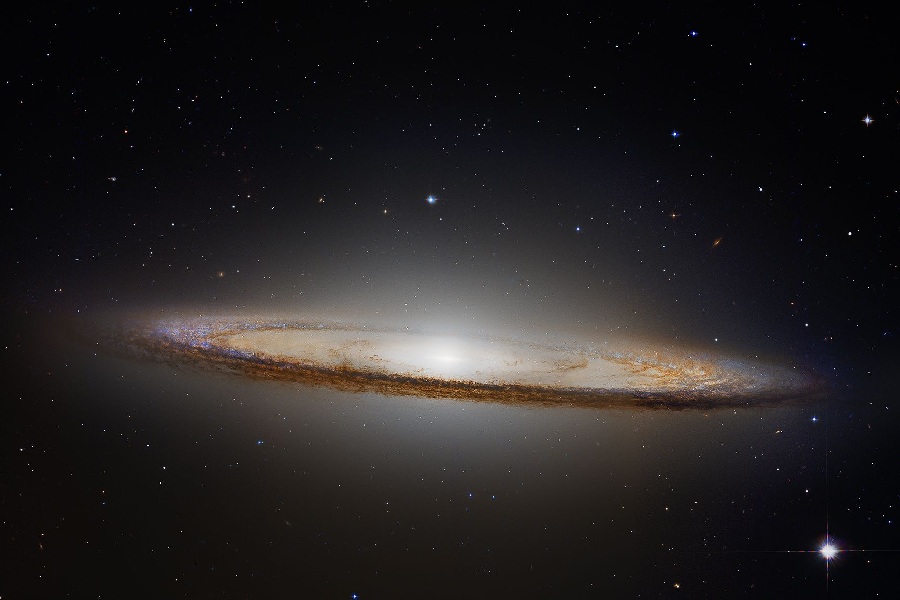The Sombrero Galaxy, also known as Messier 104, is one of the most iconic and recognizable galaxies in our night sky. With its brilliant glow and distinctive shape, it has captivated astronomers and skywatchers alike. On popular demand, we are to talk about some of the most fascinating facts about the Sombrero Galaxy, learn about its history, and how it got its name.
We will take a closer look at its central black hole, its globular cluster population, and its status as a ring galaxy. Discover how its unusual structure came to be and how it continues to evolve over cosmological timescales.
Get ready to gain new insights into one of the most prominent residents of the Virgo Galaxy Cluster. A beguiling beauty, the Sombrero Galaxy reveals its secrets as we delve into the particulars that make it extraordinary.

Facts About The Sombrero Galaxy
The Sombrero Galaxy is a beautiful spiral galaxy that has a bright central bulge and a ring of dust. This dust lane resembles a sombrero hat, hence the name. The Sombrero Galaxy exhibits symmetry and grace, captivating astronomers with its photogenic celestial beauty.
The Sombrero Galaxy appears enigmatic due to its obscuring dust lane. But new observations are unveiling hidden details. A supermassive black hole resides at the galaxy’s center.
The galaxy halo contains over 1900 ancient globular clusters. Further analysis continues to uncover insights into this majestic, mystifying galaxy.
History of Discovery
Astronomical antecedents
The Sombrero Galaxy was discovered using early telescopes. It was cataloged as a faint, fuzzy object by Charles Messier. More details emerged using larger telescopes in the 1800s. But its true nature was still uncertain, and further observations were needed to resolve its key features.
Milestone moments
Photographs in the 1900s confirmed it as a spiral galaxy. Edwin Hubble measured its distance, proving galaxies lie beyond the Milky Way. Improved telescopes enabled continued study, unveiling galactic intricacies. The Sombrero Galaxy remains an important target for understanding the cosmic scale.
Physical Characteristics of the Sombrero Galaxy
Size and beyond
The Sombrero Galaxy is huge, spanning 50,000 light-years. It lies 29 million light-years from Earth within the Virgo Cluster. Smaller satellite galaxies orbit around it. The nearby galaxies provide insights into the Sombrero’s history.
Observational perspectives
The galaxy looks different across wavelengths. Infrared radiation penetrates its dust lane, revealing more stars. X-rays show supernova remnants. Multi-wavelength observations uncover new facets. Continued observations will further unveil the galaxy’s intricacies.
Infrared Wavelengths & Infrared Light
Cosmic spectrum
Light covers a broad spectrum. Although we can see visible light, there are other wavelengths, invisible to the naked eye, which reveal hidden galactic features. Infrared light has longer wavelengths than visible light. It passes through cosmic dust clouds.
Infrared observations see through the Sombrero Galaxy’s dust lane. Studying galaxies across the spectrum gives a fuller picture of stars and structures.
Infrared also shows cooler objects like nebulae clouds and brown dwarfs glowing faintly in the night. Infrared astronomy began in the 1800s detecting infrared energy from the Sun and planets initially. Modern infrared telescopes study the cosmic infrared background glow from early universe origins.
Hidden insights
The Sombrero Galaxy’s core is obscured in visible light. But infrared telescopes see through the dust, revealing areas of intense star formation near the galactic center. Infrared also exposes old star clusters. And it highlights the active core around the central supermassive black hole.
Infrared light unveils key details within the Sombrero Galaxy. It exposes dynamic galactic phenomena enshrouded at shorter wavelengths. Infrared reveals star birth regions and highlights explosive events invisible optically. Origins of stellar nurseries, galaxy mergers, and black hole accretion shine at infrared wavelengths compared to optical blindness.
Information about the Sombrero Galaxy
Scientific significance
The Sombrero Galaxy reveals much about galaxies. Its bright bulge shows slower star formation, while its disk indicates rapid, ongoing star birth. This provides insights into stellar evolution.
The galaxy’s globular clusters also trace early cosmic epochs, and detailed study continues to advance galactic knowledge.
Cutting-edge discoveries
New observations enhance understanding. The Hubble Space Telescope photographed intricate swirling dust lanes. Extensive globular cluster populations were quantified. A supermassive black hole was verified at the galactic center.
Upcoming James Webb Space Telescope observations will uncover more. This majestic galaxy remains an important focus of astronomical research.
Conclusion
The Sombrero Galaxy remains an astronomical wonder despite centuries of study. Its iconic sombrero-shaped structure and dusty core continue to captivate scientists and enthusiasts alike.
We hope this article has helped illuminate key facts about the Sombrero Galaxy. From its elegant celestial structure to the important insights gleaned through infrared observations, this galaxy exemplifies the beauty and mysteries of our vast universe.
As cutting-edge research continues, new discoveries will further unveil the intricacies of this majestic spiral galaxy. But for now, gazing upon the stunning dust lanes and globular clusters of the Sombrero Galaxy allows us to appreciate its beauty.
This view allows us to admire the elegant details of this galaxy. This majestic galaxy also allows us to appreciate the splendors filling galaxies far beyond the Milky Way.
